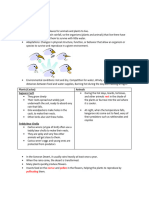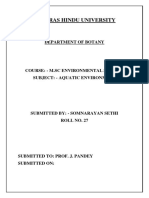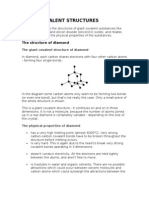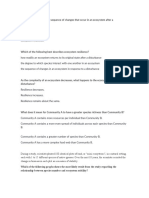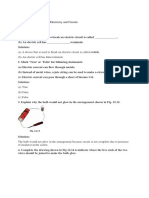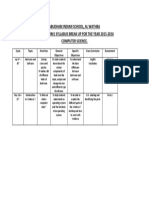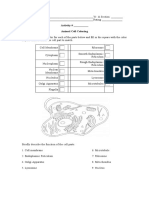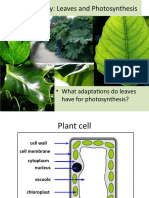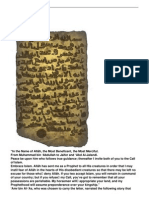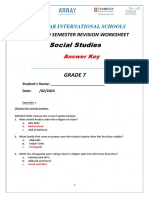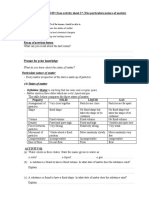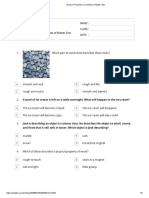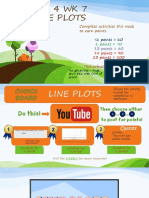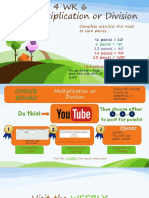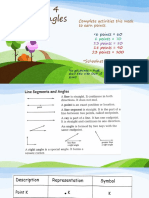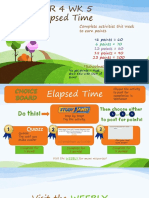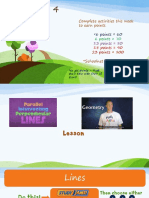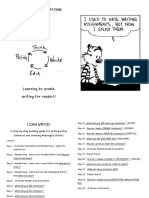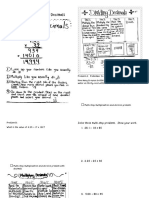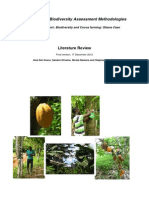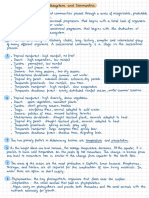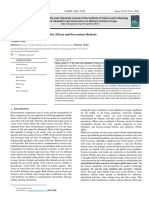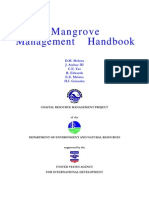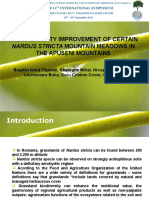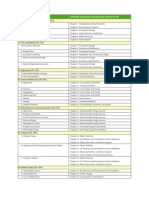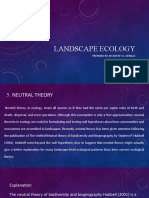Ecosystem Practice
Ecosystem Practice
Uploaded by
api-290509627Copyright:
Available Formats
Ecosystem Practice
Ecosystem Practice
Uploaded by
api-290509627Original Title
Copyright
Available Formats
Share this document
Did you find this document useful?
Is this content inappropriate?
Copyright:
Available Formats
Ecosystem Practice
Ecosystem Practice
Uploaded by
api-290509627Copyright:
Available Formats
1.
Which of the following is a living component of a desert in
California?
A.
low rainfall
B.
hot temperature
C.
polar bear
D. horned lizard
2.
Salt concentration, water temperature, plankton, and the whale
shark might all be used in a description of an ocean
A.
climate.
B.
food web.
C.
ecosystem.
D. population.
3.
Which of the following sets of organisms would be found in a
wetland ecosystem?
A.
tortoise, lizard, y
B.
salamander, mosquito, frog
C.
moose, seal, lemming
D. lion, gira e, beetle
4.
Fungi are an important part of a terrestrial ecosystem because
they
A.
store energy.
B.
bond oxygen to sulfur.
C.
function as producers.
D. recycle organic matter.
5.
The highest concentration of life exists in the top 200 meters of
ocean water. The most important factor that in uences this
concentration of life is the
A.
amount of gases at the surface.
B.
amount of nutrients in the water.
C.
large number of predators at lower depths.
D. amount of sunlight.
6.
Plants and animals are alive and have characteristics that make them di erent
from each other and non-living things.
In the chart below, list three living things and three non-living things to this picture.
Living
Non-living
Jack Rabbit
7.
Fox
Bear
What kind of habitat would all of these animals live in?
A.
Forest
B.
City
C.
Ocean
8.
All living and nonliving things that surround an animal are part
of its
A.
food chain.
B.
life cycle.
C.
environment.
D. atmosphere.
9.
Use the picture below to answer the following question.
Which of these lists only living parts of this ecosystem?
A.
fox, tree, grass
B.
sun, stream, cloud
C.
cloud, grass, rock
D. stream, cloud, fox
10.
In which group of animals below are all of the members well
adapted to living in a forest ecosystem?
A.
eld mouse, rabbit, pheasant
B.
gull, tree frog, grasshopper
C.
coyote, antelope, bison
D. squirrel, deer, woodpecker
11.
Use the diagram below to answer the following question.
The diagram shows a lake ecosystem divided into three life zones. Why is more diversity of life found in zone 1?
A.
This zone receives the most sunlight.
B.
The other two zones donmt have dissolved oxygen.
C.
It receives longer periods of sunlight daily.
D. It is always warmer than the other two zones.
12.
A wetland was drained to build a mall. Two years later, there
were no more toads in that area. Why did the toads disappear?
A.
The toads were destroyed by the construction equipment.
B.
The toads died because toads cannot breathe out of water.
C.
The toads were frightened and went into the woods.
D. The toads got their food from the wetland ecosystem.
13.
Use the picture below to answer the question.
Which of these lists only living parts of this ecosystem?
A.
fox, tree, grass
B.
sun, stream, cloud
C.
cloud, grass, rock
D. stream, cloud, fox
14.
Use the desert picture below to answer the question.
Which factor most likely limits the desert's carrying capacity for plant life?
A.
the number of herbivores
B.
the amount of sunlight
C.
the availability of water
D. the availability of land
15.
What do scientists mean when they refer to a population?
A.
all the organisms in an ecosystem
B.
all the species that share similar anatomical features
C.
all the animals that acquire resources through similar
methods
D. all the interbreeding members of a certain species in an
ecosystem
16.
A forest is ooded when a natural dam breaks, leaving the forest
oor under two meters of water. Which animal is most a ected
by the ooding?
A.
a crow
B.
a rabbit
C.
a squirrel
D. a butter y
17.
In a large forest with many animals, there are only a small
number of bears. Which of these most likely limits the
population of bears in the forest?
A.
supply of food
B.
type of tree
C.
predation by carnivores
D. amount of suitable shelter
18.
An ocean, a forest, and a grassy meadow are each examples of a
complete ecosystem. Complete ecosystems contain only
A.
animals.
B.
rocks and water.
C.
living and nonliving things.
D. populations of plants and animals.
19.
Some plants grow only in speci c places in the world. Some
cacti, for example, grow only in deserts. Which of the following
is most important in determining where a plant can grow and
survive?
A.
animals
B.
climate
C.
tides
D. wind
20.
Bison are grazing animals. They travel across a prairie, eating
grass. If there were too many bison in an area, there would
probably be
A.
fewer predators of bison.
B.
many other large grazing animals.
C.
tall shrubs and many trees.
D. less grass and more bare soil.
21.
Which of the following organisms have the greatest e ect
on an ecosystem because of the changes they make to their
environment?
A.
bees building a hive in a hollow tree
B.
wasps building a nest in a leafy bush
C.
beavers building a dam across a stream
D.
sh digging a burrow on a river bottom
22.
Which of the following climates has cold winters and hot
summers?
A.
polar
B.
subtropical
C.
temperate
D. tropical
23.
Use the information below to answer the following question(s).
The drawing below shows a eld habitat.
What is the main source of energy in the eld habitat?
A.
the sun
B.
the plants
C.
the butter y
D. the soil
24.
Use the information below to answer the following question(s).
The drawing below shows a eld habitat.
Which of these changes would be most harmful to the organisms in the eld habitat?
A.
more birds ying to the eld habitat
B.
increase of rainfall in the eld habitat
C.
students walking through the eld habitat
D. construction of a building near the eld habitat
25.
The diagram below shows the relationships among organisms living in an Atlantic coast estuary. Use the diagram to answer the following question(s).
Which of these is an abiotic factor that a ects the organisms in the estuary ecosystem?
A.
the amount of bacteria in the water
B.
the number of copepods
C.
the amount of salt in the water
D. the number of scavengers
26.
Use the information and the gure below to answer the following question(s).
Black skimmers are water birds that live along coastal beaches, bays, estuaries, and marshes.
They y just above the surface of the water using their lower jaw to catch small sh, shrimp,
and other small crustaceans.
These birds nest in simple, unlined depressions in the sand. Scientists have observed a decline
in the number of nests. Some causes of this decline include a lack of suitable nesting sites,
beach erosion, and human disturbances.
When people approach their nests, the birds become aggressive and chase away intruders. Other
animals, like crows, will take advantage of the unprotected nests and feed on the eggs.
Which of these best describes the e ects of human disturbance on the black skimmer's eggs?
A.
a biotic factor
B.
an allele
C.
a niche
D. an abiotic factor
27.
Which abiotic factor limits the altitude at which plants can grow?
A.
the presence of a parasite
B.
the temperature of the area
C.
the presence of herbivorous animals
D. the concentration of microbes in the soil
28.
Members of the same species found in an ecosystem are called
a
A.
family.
B.
population.
C.
niche.
D. community.
29.
A grassland biome does not naturally support trees because there
is a
A.
lack of humus in the soil.
B.
lack of adequate precipitation.
C.
layer of permafrost which prevents trees from establishing
roots.
D. large number of predatory insects which destroy young trees.
30.
Large herbivores help maintain which terrestrial biome?
A.
Desert
B.
Grassland
C.
Rain forest
D. Tundra
Problem-Attic format version 4.4.229
c 20112015 EducAide Software
_
Licensed for use by Vanda Bell
Terms of Use at www.problem-attic.com
Abiotic and Biotic
10/16/2015
1.
Answer:
21.
Answer:
2.
Answer:
22.
Answer:
3.
Answer:
23.
Answer:
4.
Answer:
24.
Answer:
5.
Answer:
25.
Answer:
6.
Answer:
26.
Answer:
7.
Answer:
27.
Answer:
8.
Answer:
28.
Answer:
9.
Answer:
29.
Answer:
10.
Answer:
30.
Answer:
11.
Answer:
12.
Answer:
13.
Answer:
14.
Answer:
15.
Answer:
16.
Answer:
17.
Answer:
18.
Answer:
19.
Answer:
20.
Answer:
You might also like
- Aquatic Ecosystems Biomes Ws hw2Document3 pagesAquatic Ecosystems Biomes Ws hw2api-32497809071% (7)
- Y8 Science - Chapter 4 EcosystemsDocument8 pagesY8 Science - Chapter 4 EcosystemsevelenewongNo ratings yet
- Ecology-Unit-With-Labs-Worksheets-Assgnments For 10th GradeDocument27 pagesEcology-Unit-With-Labs-Worksheets-Assgnments For 10th GradeMauricio AragonNo ratings yet
- 5th Grade Science Eog Vocabulary Study GuideDocument6 pages5th Grade Science Eog Vocabulary Study Guideapi-290509627No ratings yet
- Wetlands of India (Assignment Task)Document28 pagesWetlands of India (Assignment Task)Cryogen101 TheAssassinNo ratings yet
- Environmental Science Lesson 1Document36 pagesEnvironmental Science Lesson 1Nick John SaquibalNo ratings yet
- Eou EltiatDocument4 pagesEou EltiatJoel MagbanuaNo ratings yet
- Hibernation Play ReneeDocument6 pagesHibernation Play Reneeapi-489881515No ratings yet
- Etiquettes of Recitation Worksheets For Grade 3Document6 pagesEtiquettes of Recitation Worksheets For Grade 3Gradethree PechsNo ratings yet
- Lesson Plan 5 - Deforestation-So WhatDocument5 pagesLesson Plan 5 - Deforestation-So Whatapi-547106143No ratings yet
- States of Matter Grade - IV 2021-2022 UnsolvedDocument6 pagesStates of Matter Grade - IV 2021-2022 UnsolvedManisha Thakur100% (1)
- Science-9 Q1 Mod4 Biodiversity-And-Evolution VerFinal-2Document10 pagesScience-9 Q1 Mod4 Biodiversity-And-Evolution VerFinal-2Tantan Andrei100% (1)
- Leaves and PhotosynthesisDocument18 pagesLeaves and Photosynthesisapi-309893409100% (1)
- Ecosystems TestDocument5 pagesEcosystems Testapi-350851724No ratings yet
- Ib ChemistryDocument25 pagesIb ChemistryNikol Gali100% (1)
- Deforestation 3 Fun Activities Games 1024Document1 pageDeforestation 3 Fun Activities Games 1024Luz CastellanosNo ratings yet
- 2015 NYJC H2 Chem PrelimDocument55 pages2015 NYJC H2 Chem PrelimTan Jia YiNo ratings yet
- Blended CurriculumDocument64 pagesBlended Curriculumnumbersdatabase100% (1)
- Giant Covalent Structures (SL)Document5 pagesGiant Covalent Structures (SL)Brooks RalphNo ratings yet
- Chemistry IgcseDocument70 pagesChemistry IgcseajNo ratings yet
- Ecosystem Resilience WorksheetDocument4 pagesEcosystem Resilience WorksheetJuan José Zapata FrancoNo ratings yet
- Isotope and Relative Atomic MassDocument14 pagesIsotope and Relative Atomic Massapi-238421605100% (2)
- Electricity and Circuits PPT 4Document16 pagesElectricity and Circuits PPT 4aadit thakral100% (1)
- MUET Grammar - Past Continuous TenseDocument7 pagesMUET Grammar - Past Continuous TenseIda Ikhwan 이다 잌환No ratings yet
- Circuit Builder SEDocument6 pagesCircuit Builder SEKing cobraNo ratings yet
- The Pyp Exhibition Grade 5: Tuesday 12thmay 2014 Parent InformationDocument13 pagesThe Pyp Exhibition Grade 5: Tuesday 12thmay 2014 Parent InformationcrdaymentNo ratings yet
- Chapter 12 Electricity and CircuitsDocument4 pagesChapter 12 Electricity and CircuitsSampathkumar100% (1)
- Syllabus Break Up Grade 3 - Term 1Document1 pageSyllabus Break Up Grade 3 - Term 1Kesanam SpNo ratings yet
- English 101: Unit Composition SkillsDocument30 pagesEnglish 101: Unit Composition Skillskroomsh212100% (1)
- VIII NSO MOCK TEST 3 (v3)Document9 pagesVIII NSO MOCK TEST 3 (v3)neomatrix70No ratings yet
- Food Chains in The WoodlandDocument2 pagesFood Chains in The Woodlandapi-254428474No ratings yet
- Cell Coloring ActDocument1 pageCell Coloring ActArby LagradaNo ratings yet
- MYP5 Biology: Leaves and PhotosynthesisDocument17 pagesMYP5 Biology: Leaves and PhotosynthesisAref Dahabrah100% (1)
- Simple Kinetic Molecular Model of Matter 5 QPDocument15 pagesSimple Kinetic Molecular Model of Matter 5 QPputri aNo ratings yet
- Detailed Lessons For Writing Poetry 5 Grade (11 Days of Lessons)Document16 pagesDetailed Lessons For Writing Poetry 5 Grade (11 Days of Lessons)Lullaby87No ratings yet
- Adverbs Notes + WorksheetDocument4 pagesAdverbs Notes + WorksheetAryan PurwarNo ratings yet
- Assignment 01 - FullDocument12 pagesAssignment 01 - FullDivya PritamNo ratings yet
- D. Isotopes WorksheetDocument2 pagesD. Isotopes WorksheetKarissa100% (1)
- Grade 1 English Teaching Planning Tool and Resoruce Implications - ExmapleDocument7 pagesGrade 1 English Teaching Planning Tool and Resoruce Implications - ExmapleDerek William NicollNo ratings yet
- Letter To The King of Oman.Document3 pagesLetter To The King of Oman.Mikel AlonsoNo ratings yet
- Chapter17-Lesson 2Document23 pagesChapter17-Lesson 2api-185034533No ratings yet
- G7 S.S Revision Worksheet Answer Key - Second TermDocument11 pagesG7 S.S Revision Worksheet Answer Key - Second TermShi UzumakiNo ratings yet
- Y10 Plant Transport Lesson 1Document27 pagesY10 Plant Transport Lesson 1Sherry LeeNo ratings yet
- Dialogue WritingDocument2 pagesDialogue WritingMaria sheila BalistaNo ratings yet
- Charlie and The Chocolate Factory Essay TopicsDocument1 pageCharlie and The Chocolate Factory Essay TopicsOana ArdeleanuNo ratings yet
- June 2016 QP - Unit 1 Edexcel Chemistry A LevelDocument24 pagesJune 2016 QP - Unit 1 Edexcel Chemistry A LevelSareb MurtadaNo ratings yet
- Topical Test ElectricityDocument3 pagesTopical Test ElectricityAxien YahyaNo ratings yet
- Atomic Structure & The Periodic Table 1 QPDocument8 pagesAtomic Structure & The Periodic Table 1 QPAisha Jakhro100% (1)
- Solids Liquids and GasesDocument18 pagesSolids Liquids and GasesGeraldNo ratings yet
- Activity Sheet-27 (Particulate Nature of Matter)Document5 pagesActivity Sheet-27 (Particulate Nature of Matter)Nkemzi NzetengenleNo ratings yet
- Ecosystems Project RubricDocument2 pagesEcosystems Project Rubricapi-2697914590% (1)
- Alwadi International School Grade 9 Biology 10. Diseases and Immunity NotesDocument35 pagesAlwadi International School Grade 9 Biology 10. Diseases and Immunity NotesMohammed HelmyNo ratings yet
- B2 Movement in & Out of CellsDocument20 pagesB2 Movement in & Out of CellsHai Anh LeNo ratings yet
- Transport in PlantsDocument26 pagesTransport in Plantsliban100% (1)
- Animal Extinction Quiz QuestionsDocument7 pagesAnimal Extinction Quiz QuestionsHiruna SandeepaNo ratings yet
- Podar International School (ICSE) - Nerul: Progress Report For Term II (2019-2020 - Morning Shift)Document1 pagePodar International School (ICSE) - Nerul: Progress Report For Term II (2019-2020 - Morning Shift)sandeepkumar2311100% (1)
- Grade 3 Properties and States of Matter TestDocument3 pagesGrade 3 Properties and States of Matter TestaugustNo ratings yet
- Transport and Transpiration in Plants NOTESDocument10 pagesTransport and Transpiration in Plants NOTESYasmin YehiaNo ratings yet
- Igcse Doubleaward Chem Lessonplan Ch01Document5 pagesIgcse Doubleaward Chem Lessonplan Ch01Truong Nguyen DucNo ratings yet
- 10.1 - Earth's Supply of WaterDocument4 pages10.1 - Earth's Supply of Waterapi-251806635100% (1)
- Line PlotsDocument6 pagesLine Plotsapi-290509627No ratings yet
- RoundingDocument6 pagesRoundingapi-290509627No ratings yet
- Fun MeasurementDocument10 pagesFun Measurementapi-290509627No ratings yet
- SymmetryDocument18 pagesSymmetryapi-290509627No ratings yet
- Multiplication and DivisionDocument7 pagesMultiplication and Divisionapi-290509627No ratings yet
- Multi-Step Multiplication and DivisionDocument3 pagesMulti-Step Multiplication and Divisionapi-290509627No ratings yet
- VocabularyDocument3 pagesVocabularyapi-290509627No ratings yet
- Naming AnglesDocument10 pagesNaming Anglesapi-290509627No ratings yet
- More MeasurementDocument7 pagesMore Measurementapi-290509627No ratings yet
- Telling TimeDocument8 pagesTelling Timeapi-290509627No ratings yet
- The Moon Problem Attic Test For StudentsDocument30 pagesThe Moon Problem Attic Test For Studentsapi-290509627No ratings yet
- QuadrilateralsDocument16 pagesQuadrilateralsapi-290509627No ratings yet
- QTR 1 VocabularyDocument26 pagesQTR 1 Vocabularyapi-290509627No ratings yet
- LinesDocument3 pagesLinesapi-290509627No ratings yet
- Lattice MultiplicationDocument29 pagesLattice Multiplicationapi-290509627No ratings yet
- Razzle Dazzle Journal PagesDocument12 pagesRazzle Dazzle Journal Pagesapi-290509627No ratings yet
- QTR 1 WK 1 VocabularyDocument2 pagesQTR 1 WK 1 Vocabularyapi-290509627No ratings yet
- QTR 1 WK 3Document3 pagesQTR 1 WK 3api-290509627No ratings yet
- 5th Grade Science Weather Vocabulary CardsDocument2 pages5th Grade Science Weather Vocabulary Cardsapi-290509627No ratings yet
- Biome Diorama ProjectDocument6 pagesBiome Diorama Projectapi-290509627No ratings yet
- Brain Pop QuizDocument1 pageBrain Pop Quizapi-290509627No ratings yet
- 5th Grade Science Energy Transfer Vocabulary CardsDocument2 pages5th Grade Science Energy Transfer Vocabulary Cardsapi-290509627No ratings yet
- 5th Grade Science Properties of Matter Vocabulary CardsDocument2 pages5th Grade Science Properties of Matter Vocabulary Cardsapi-290509627No ratings yet
- QTR 3 WK 3Document2 pagesQTR 3 WK 3api-290509627No ratings yet
- QTR 2 WK 4aDocument4 pagesQTR 2 WK 4aapi-290509627No ratings yet
- QTR 2 WK 6bDocument3 pagesQTR 2 WK 6bapi-290509627No ratings yet
- QTR 1 WK 7Document7 pagesQTR 1 WK 7api-290509627No ratings yet
- 1.1 General:: Biological Nutrient RemovalDocument21 pages1.1 General:: Biological Nutrient Removalವಿನಯ್ ಎಮ್. ಆರ್No ratings yet
- Article Environment: Vanishing ForestsDocument2 pagesArticle Environment: Vanishing ForestsAlchemyNo ratings yet
- CH 02 - BioDocument20 pagesCH 02 - Bioklopos1234No ratings yet
- Applying Local KnowledgeDocument13 pagesApplying Local KnowledgechazunguzaNo ratings yet
- Water Pollution07Document12 pagesWater Pollution07mechjobs4me100% (1)
- Wetland BiodiversityDocument9 pagesWetland Biodiversityusthb29No ratings yet
- Biodiversity of Cacao in Ghana PDFDocument83 pagesBiodiversity of Cacao in Ghana PDFShreeRajShresthaNo ratings yet
- Chapter 6 Review QuestionDocument2 pagesChapter 6 Review QuestionThithi24No ratings yet
- 10 47769-Izufbed 862679-1514334Document4 pages10 47769-Izufbed 862679-1514334Jack MarrowNo ratings yet
- Unit 6: Gizmos Lab Simulation: Coral Reefs 1 - Abiotic FactorsDocument7 pagesUnit 6: Gizmos Lab Simulation: Coral Reefs 1 - Abiotic Factorsjibityy junnn0% (1)
- t2 e 2197 Y5 Rainforests Differentiated Reading Comprehension ActivityDocument9 pagest2 e 2197 Y5 Rainforests Differentiated Reading Comprehension ActivityshalNo ratings yet
- Current Status and Species Diversity of Seagrass in Panjang Island, BantenDocument8 pagesCurrent Status and Species Diversity of Seagrass in Panjang Island, BantenAktifitas 2022No ratings yet
- Mangrove Management Handbook FaoDocument116 pagesMangrove Management Handbook FaoDwi JuliantoNo ratings yet
- Eco SystemDocument32 pagesEco SystemIravati RayNo ratings yet
- Coastal Waters of Boracay Island, Malay, Aklan, Central PhilippinesDocument15 pagesCoastal Waters of Boracay Island, Malay, Aklan, Central PhilippinesRupelma Salazar PatnugotNo ratings yet
- What Is Oxidation-Reduction Potential?Document2 pagesWhat Is Oxidation-Reduction Potential?dban21No ratings yet
- Biodiversity and A Healthy SocietyDocument33 pagesBiodiversity and A Healthy SocietyMarc Geoffrey HababNo ratings yet
- Human Impact On WaterDocument19 pagesHuman Impact On Waterxinob lirabNo ratings yet
- Ecosystems (16780 1Document16 pagesEcosystems (16780 1Mais AlizadaNo ratings yet
- Biodiversity and The Healthy SocietyDocument24 pagesBiodiversity and The Healthy SocietyCHARLOTTE JAZMINE RAMIREZNo ratings yet
- The Trophicity Improvement of CERTAIN Nardus Stricta Mountain Meadows IN The Apuseni MountainsDocument10 pagesThe Trophicity Improvement of CERTAIN Nardus Stricta Mountain Meadows IN The Apuseni MountainsFăgădar Bogdan IonuțNo ratings yet
- MABR Product Brochure Aug19Document4 pagesMABR Product Brochure Aug19e.mostafa.abdelhadyNo ratings yet
- Intertidal ZoneDocument3 pagesIntertidal ZoneDIANA APILADONo ratings yet
- June04.2015house Passes National Mangrove Forest Conservation and Rehabilitation ActDocument2 pagesJune04.2015house Passes National Mangrove Forest Conservation and Rehabilitation Actpribhor2No ratings yet
- Anoxic Tank in Sugar IndustryDocument13 pagesAnoxic Tank in Sugar Industrytliinh1209No ratings yet
- Friedland Apes CorrelationDocument1 pageFriedland Apes Correlationapi-240829482No ratings yet
- Landscape EcologyDocument19 pagesLandscape Ecologyargie joy marieNo ratings yet
- Trees Outside ForestsDocument58 pagesTrees Outside ForestsdanieloshkaNo ratings yet

